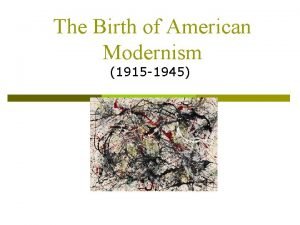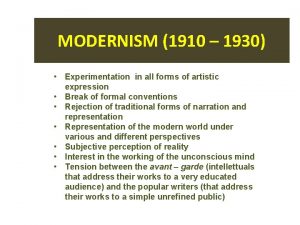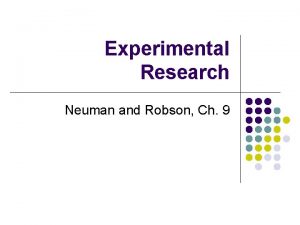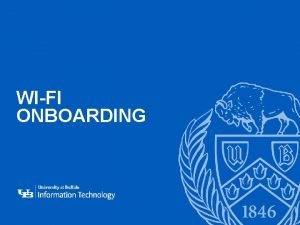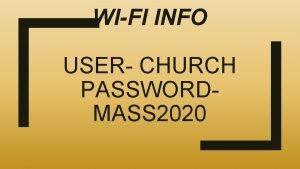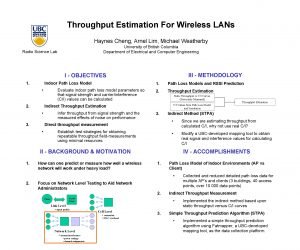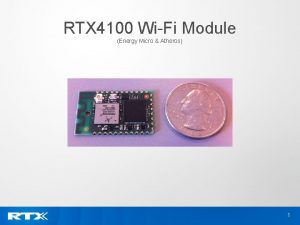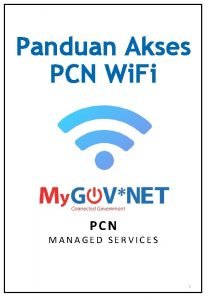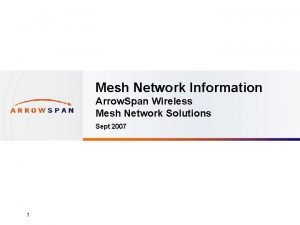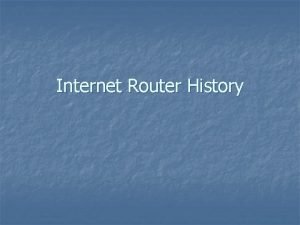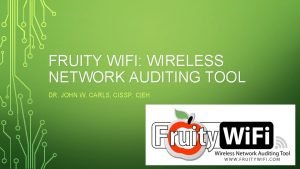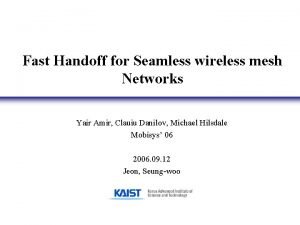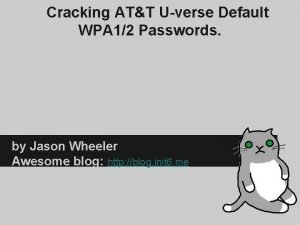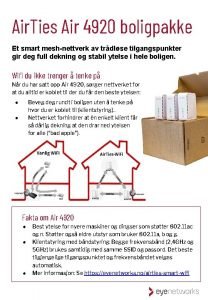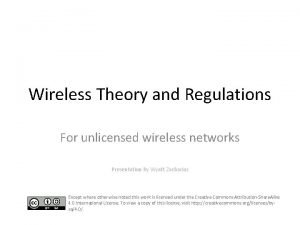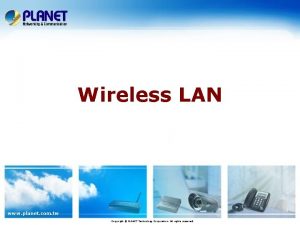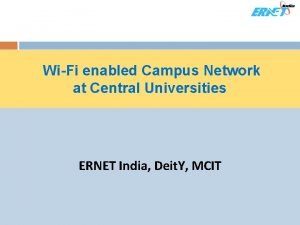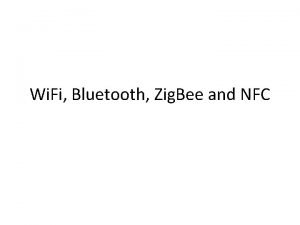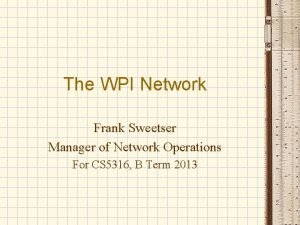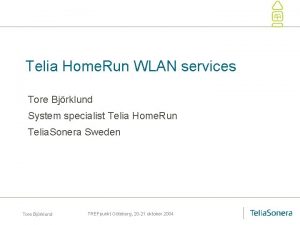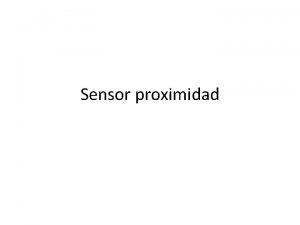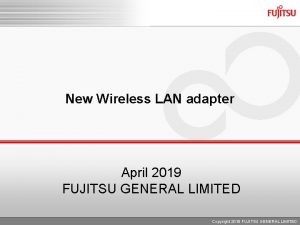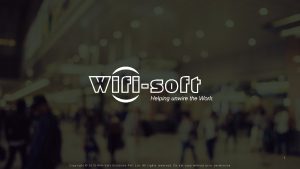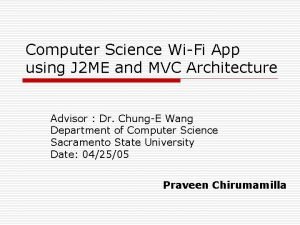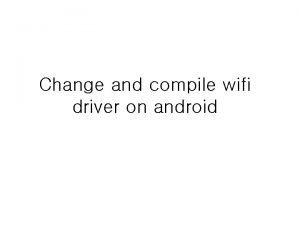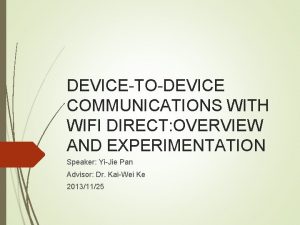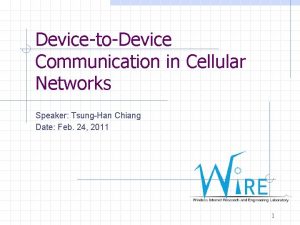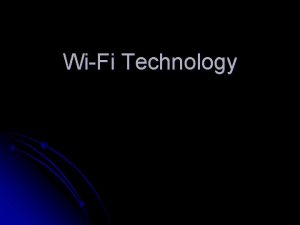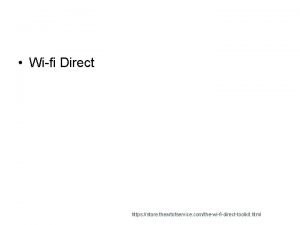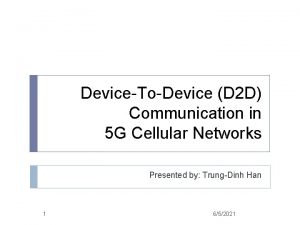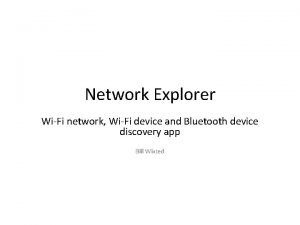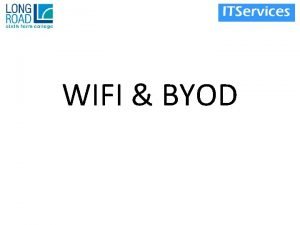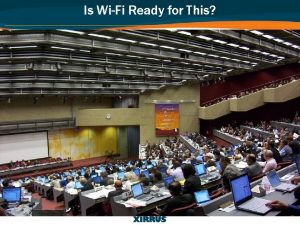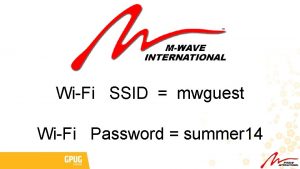DEVICETODEVICE COMMUNICATION WITH WIFI DIRECT OVERVIEW EXPERIMENTATION Speaker








































- Slides: 40

DEVICE-TO-DEVICE COMMUNICATION WITH WI-FI DIRECT : OVERVIEW & EXPERIMENTATION Speaker : Liang-Lin Yan Advisor : Dr. Ho-Ting Wu 2014/12/2

OUTLINE Introduction n D 2 D Communication n Wi-Fi Direct n Experimental Evaluation n Conclusion n References n 2

INTRODUCTION The IEEE 802. 11 standard , has become one of the most common ways to access the Internet. Given the wide adoption of Wi-Fi in many kinds of devices, a natural way for the technology to progress is to target device-to-device connectivity, i. e. without requiring the presence of an Access Point (AP) 3

INTRODUCTION Direct device to device connectivity was already possible in the original IEEE 802. 11 standard by means of the ad hoc mode of operation. There have several drawbacks when facing nowadays requirements, e. g. lack of efficient power saving support or extended Qo. S capabilities. 4

INTRODUCTION The Wi-Fi Direct technology approach to enhance device to device connectivity. Instead of leveraging the ad-hoc mode of operation. Wi-Fi Direct builds upon the successful IEEE 802. 11 infrastructure mode and lets devices negotiate who will take over the AP-like functionalities. 5

INTRODUCTION Legacy Wi-Fi devices may seamlessly connect to Wi-Fi Direct devices and immediately inherits all the enhanced Qo. S, power saving, and security mechanisms developed for the Wi-Fi infrastructure mode in the past years. 6




DEVICE-TO-DEVICE COMMUNICATION D 2 D conmmunication 示意圖 10


WI-FI DIRECT : ARCHITECTURE Wi-Fi Direct devices, formally known as P 2 P Devices, communicate by establishing P 2 P Groups. u P 2 P Group Owner: the device implementing AP-like functionality in the P 2 P Group u P 2 P Clients: devices acting as clients When two P 2 P devices discover each other they negotiate their roles to establish a P 2 P Group. 12

WI-FI DIRECT : ARCHITECTURE P 2 P Group is established, other P 2 P Clients can join the group as in a traditional Wi-Fi network. As long as devices are not 802. 11 b only devices and support the required security mechanisms. Legacy devices do not formally belong to the P 2 P Group, but they simply “see” the P 2 P GO as a traditional AP. 13

WI-FI DIRECT 14

WI-FI DIRECT : GROUP OWNER(GO) Announce itself through beacons Support power saving services for its associated clients Run a DHCP server to provide clients with IP addresses Wi-Fi-Direct does not allow the transfer of GO role within a group and if the GO leaves the group, the group is torn down and has to be re-established 15

WI-FI DIRECT : GROUP FORMATION Standard � P 2 P devices have to negotiate the role of P 2 P GO Autonomous � A P 2 P device may autonomously create a P 2 P Group Persistent � There is some pre-shared security information available 16

GROUP FORMATION: STANDARD Wi-Fi Direct devices usually start Wi-Fi scan (active or passive) to discover existent P 2 P Groups and Wi-Fi networks After this scan, a new algorithm is executed 1. A P 2 P Device selects one of the so-called Social channels, namely channels 1, 6 or 11 in the 2. 4 GHz band, as its Listen channel. 17

GROUP FORMATION: STANDARD 2. A P 2 P Device alternates between two states n n Search state: the device performs active scanning by sending Probe Requests in each of the social channels Listen state: the device listens for Probe Requests in its listen channel to respond with Probe Responses 18

GROUP FORMATION: STANDARD GO Negotiation n Once the two P 2 P devices have found each other, they start the GO Negotiation phase n Implemented using a three-way handshake, namely GO Negotiation Request/Response/Confirmation l The two devices agree on which device will act as P 2 P GO and on the channel where the group will operate, which can be in the 2. 4 GHz or 5 GHz bands. 19

GROUP FORMATION: STANDARD WPS (Wi-Fi Protected Setup) Provisioning � Establishment of a secure communication using Wi-Fi Protected Setup Address Config. �A DHCP exchange to set up the IP configuration 20

GROUP FORMATION: STANDARD 21

GROUP FORMATION: AUTONOMOUS A P 2 P device may autonomously create a P 2 P Group, where it immediately becomes the P 2 P GO, by sitting on a channel and starting to beacon. Other devices can discover the established group using traditional scanning mechanisms, and then directly proceed with the WPS Provisioning and Address Configuration phases. 22

GROUP FORMATION: AUTONOMOUS 23

GROUP FORMATION: PERSISTENT P 2 P devices can declare a group as persistent, by using a flag in the P 2 P Capabilities attribute present in Beacon frames, Probe Responses and GO negotiation frames. The devices forming the group store network credentials and the assigned P 2 P GO and Client roles for subsequent re-instantiations of the P 2 P group. 24

GROUP FORMATION: PERSISTENT After the Discovery phase, if a P 2 P device recognizes to have formed a persistent group with the corresponding peer in the past, any of the two P 2 P devices can use the Invitation Procedure (a two-way handshake) to quickly re-instantiations the group. 25

GROUP FORMATION: PERSISTENT 26

WI-FI DIRECT : LAYER TWO SERVICE DISCOVERY A salient feature of Wi-Fi Direct is the ability to support service discovery at the link layer. Prior to the establishment of a P 2 P Group, P 2 P Devices can exchange queries to discover the set of available services and, based on this, decide whether to continue the group formation or not. 27

WI-FI DIRECT : LAYER TWO SERVICE DISCOVERY In order to service discovery queries generated by a higher layer protocol, e. g. , UPn. P, are transported at the link layer using the Generic Advertisement Protocol (GAS) specified by 802. 11 u. 28

WI-FI DIRECT : SECURITY Wi-Fi Direct devices are required to implement Wi-Fi Protected Setup (WPS) to support a secure connection with minimal user intervention. WPS allows to establish a secure connection � Introducing a PIN in the P 2 P Client � Pushing a button in the two P 2 P Devices. 29

WI-FI DIRECT : SECURITY Registrar (by GO) is in charge of generating and issuing the network credentials to the Enrollee (by clients). The Enrollee disassociates and reconnects using its new authentication credentials. 30

WI-FI DIRECT : POWER SAVING Using Wi-Fi Direct, battery-constrained devices may typically act as P 2 P GO and therefore energy efficiency is of capital importance. Wi-Fi Direct defines two new power saving mechanisms for APs: 1. 2. Opportunistic Power Save protocol Notice of Absence (No. A) protocol 31

EXPERIMENTAL EVALUATION 1. To analyze the time required to form a P 2 P group for the three cases described in the previous section. 2. To quantify the achievable performance trade-offs using Wi-Fi Direct and compare them against legacy operation. 32

TESTBED SETUP Deploy a testbed consisting of two nodes in an office environment, where different WLANs could be detected, and perform the experiments during working. The nodes are two laptops equipped with an 802. 11 a/b/g D-Link PCMCIA card with an Atheros chipset, running Linux and the mac 80211/ath 5 k driver. 33

TESTBED SETUP Use an open source implementation of Wi-Fi Direct, which builds on the widely deployed wpa_supplicant software, and extend it to implement the Notice of Absence (No. A) protocol. Implement No. A as this mechanism provides the AP with the tightest control and should provide the maximum energy savings. Throughout experiments always pre-provision the devices with a WPS PIN, to support automatized execution. 34

GROUP FORMATION DELAY 35

ENERGY-EFFICIENT OPERATION 36

CONCLUSION Wi-Fi has become a predominant way to access the Internet wirelessly, it is now embracing the challenge of becoming pervasive also in direct device to device communications. Wi-Fi Alliance has recently developed the Wi-Fi Direct technology that builds upon the Wi-Fi infrastructure mode to enable direct device to device connectivity. 37

REGARDING FUTURE RESEARCH DIRECTIONS 1. The No. A protocol could also be re-used to virtualize the roles of P 2 P GO/Client over multiple concurrent P 2 P Groups. 2. Concurrent operation together with the dynamic nature of the P 2 P GO/Client roles could be used to improve performance in dense environments, for instance by means of dynamic relays. 3. If Wi-Fi Direct becomes a widespread technology as expected, it faces the challenge of improving coexistence and reducing interference with other unlicensed devices. 38

REFERENCES D. Camps-Mur, A. Garcia-Saavedra, and P. Serrano, "Device-to-device communications with Wi-Fi Direct: overview and experimentation, " IEEE Wireless Communications, vol. 20, no. 3, Jun. 2013. 39

Thanks for your listening! 40
 Modernism and experimentation in american literature
Modernism and experimentation in american literature Active experimentation
Active experimentation Experimentation in modernism
Experimentation in modernism Research/experimentation sae examples
Research/experimentation sae examples Experimentation in modernism
Experimentation in modernism R x o research design
R x o research design Matthew robson
Matthew robson Human experimentation code
Human experimentation code Traditional poetry vs modern poetry
Traditional poetry vs modern poetry Marc train wifi
Marc train wifi Wireless onboarding
Wireless onboarding Ncsu eduroam
Ncsu eduroam Church wifi password
Church wifi password Ucopia login
Ucopia login Arnel wifi
Arnel wifi Facebook wi-fi
Facebook wi-fi Ruckus deal registration
Ruckus deal registration Rtx4100
Rtx4100 Pcn wifi staff
Pcn wifi staff Arrow mesh wifi
Arrow mesh wifi Lcps secure wifi password
Lcps secure wifi password First router
First router Urlsnarf
Urlsnarf Mesh wifi handoff
Mesh wifi handoff Att uverse security
Att uverse security Airties smart wifi
Airties smart wifi Raisecom colombia
Raisecom colombia Wifi theory
Wifi theory Planet usb wifi adapter driver
Planet usb wifi adapter driver Iitd wifi settings
Iitd wifi settings Wifi vs zigbee
Wifi vs zigbee Wpi wifi setup
Wpi wifi setup Telia jobbmobil
Telia jobbmobil Telenet wi free
Telenet wi free Eduroam wifi jelszó szte
Eduroam wifi jelszó szte Sensor de proximidad
Sensor de proximidad Uty-tfsxf3
Uty-tfsxf3 Milli k?t?phane
Milli k?t?phane Wifisoft
Wifisoft Wifi-2me
Wifi-2me Skb_mac_header
Skb_mac_header
